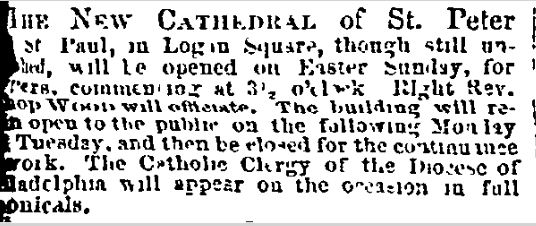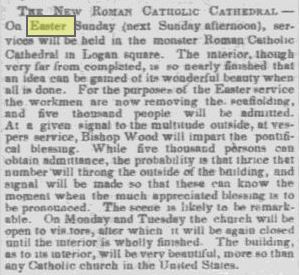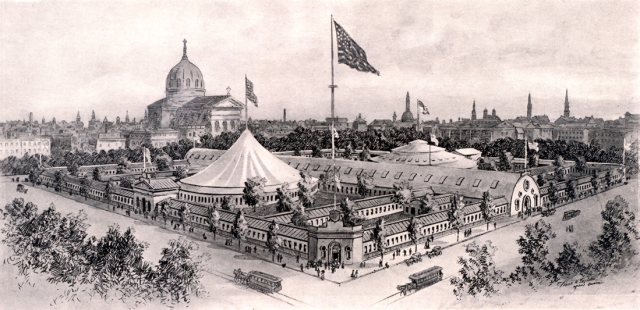Easter 1862 – Cathedral Basilica of Saints Peter and Paul, Philadelphia
Posted By Norman Gasbarro on April 8, 2012
Easter, celebrated on 20 April 1862, was the first opportunity of Philadelphia’s Roman Catholics to worship in the nearly completed Cathedral Basilica of Saints Peter and Paul on Logan Square. This Easter marks the 150th anniversary of the first time the building was used for worship.
The picture of the basilica is from around 1970 and is part of the archives at PhillyHistory.org.
Articles appearing in the Philadelphia Inquirer and the North American and United States Gazette heralded the first use of the building:
THE NEW CATHEDRAL of St. Peter and St. Paul in Logan Square, though still unfinished, will be opened on Easter Sunday for prayers commencing at 3 o’clock. right Reverend Bishop Wood will officiate. The building will remain open to the public on the following Monday and Tuesday and then be closed for the continuing work. The Catholic Clergy of the Diocese of Philadelphia will appear on the occasion in full canonicals.
ST. PAUL’S ROMAN CATHOLIC CHURCH — The work upon this edifice is now progressing quite rapidly. The cross for the front of the building has been erected. It is entirely gilded, and about ten feet in height. The one upon the cupola is also gilded, and is eighteen feet long and nine feet wide. Work will be immediately commenced on the interior, and it is hoped that it will be ready for worship by the first of July. A fair will be commenced in Sansom Street Hall on Easter Monday, and will continue for two weeks, the proceeds to be dedicated to the completion of the church.
THE NEW ROMAN CATHEDRAL CATHEDRAL – On Easter Sunday (next Sunday afternoon), services will be held in the monster Roman Catholic Cathedral on Logan Square. The interior, though very far from completed, is so nearly finished that an idea can be gained on its wonderful beauty when all is done. For the purposes of the Easter service the workmen are now removing the scaffolding and five thousand people will be admitted. At a given signal to the multitude outside, at vespers service, Bishop Wood will impart the pontifical blessing. While five thousand persons can obtain admittance, the probability is that thrice that number will throng the outside of the building, and signal will be made so that these can know the moment when the much appreciated blessing is to be pronounced. The scene is likely to be remarkable. On Monday and Tuesday the church will be open to visitors, after which it will again be closed until the interior is wholly finished. The building, as to its interior, will be very beautiful, more so than any Catholic church in the United States.
The Cathedral Basilica was a dominant feature of Logan Square during the Civil War as can be seen from the picture of the United States Sanitary Fair which was held in Philadelphia in June 1864.

The color picture of the United States Sanitary Commission Fair is from the web site of the Historical Society of Pennsylvania. The black and white picture of the Sanitary Commission Fair is from an engraving found on the Civil War Research Engine of Dickinson College. Different versions of the picture, including those for sale in print form (various sizes) can easily be found by searching for “Sanitary Commission Fair” images via any search engine.
Some of the previous blog articles on the Catholic church in Pennsylvania and in the Lykens Valley area can be located by clicking on the titles below:
Sacred Heart of Jesus Church and Cemetery, Williamstown
Gov. William Alexis Stone (James Cardinal Gibbons role in Coal Miners Strike)
Williamstown-Williams Township Historical Society (Budd Family role in establishment of church in Lykens Valley area)
Dalmatia Civil War Veterans (Roman Catholic mission to Dalmatia)
Easter 1861 (celebration of Easter in Philadelphia)
The Execution of Deserters and an All-Denominational Funeral
To access a list of all blog articles which have included information about the Catholic Church, use the search term “Catholic.”
 ;
;







Comments